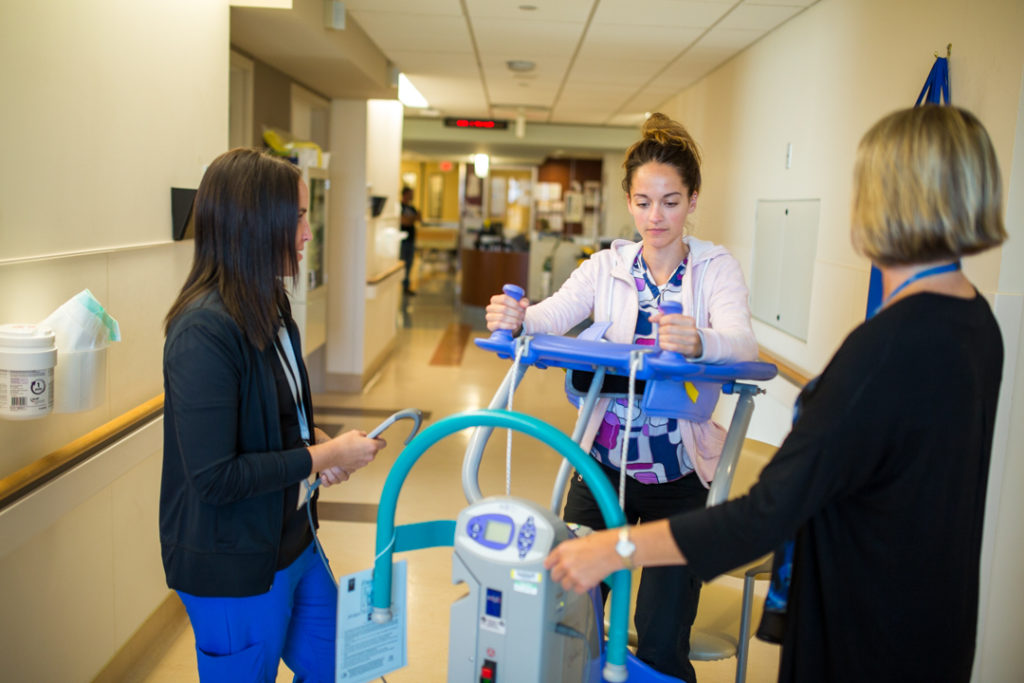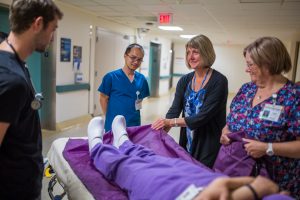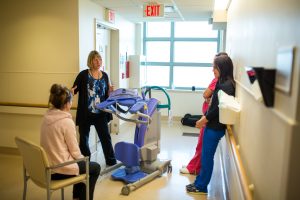
Supporting safe patient handling
Registered nurse Fran Schaaf has seen a lot of change in the 21 years she has worked at Juravinski Hospital and Cancer Centre. One of the greatest changes she has experienced might not be noticed at a glance. It has happened gradually over time, but still significantly affects Fran and her colleagues. The average weight of patients has increased considerably since she started nursing, as has the level of dementia in the people she cares for.
These two factors, along with many others, have led to high levels of injury among Fran’s colleagues on unit E3, and across Hamilton Health Sciences (HHS).
“I remember this one patient who had an acquired brain injury,” recalls Fran. “He was a seizure patient and was about to rip out an IV. We had six people ready to move him and we thought he was secured. But he kicked me in the head and chest and knocked me into the next bed.”
Fran suffered whiplash and had to be on modified work duties for several weeks.
“We have a lot of obese patients, and a lot of patients with dementia, which can lead to unpredictable behaviours,” Fran says. “We knew our injury numbers were high and that we had to do something about it.”
In 2015, Fran’s unit, along with select others, was chosen as a pilot for the Safe Patient Handling Program led by Ergonomics.
“Now, we take time to assess, and get extra hands or devices as needed.”
 “About a quarter of all lost time injuries at Hamilton Health Sciences are related to patient handling,” notes Lisa Gilmour, manager of Health, Safety and Wellness Initiatives at HHS. “We wanted to create a complete environment to promote safe patient handling. The program includes teaching staff proper techniques, making equipment readily available, and providing ongoing support.”
“About a quarter of all lost time injuries at Hamilton Health Sciences are related to patient handling,” notes Lisa Gilmour, manager of Health, Safety and Wellness Initiatives at HHS. “We wanted to create a complete environment to promote safe patient handling. The program includes teaching staff proper techniques, making equipment readily available, and providing ongoing support.”
The team rolled out a training program, starting with high injury units, with a goal of reducing musculoskeletal injuries. The program includes training on patient handling equipment, peer coaching, and a tool to help staff assess the degree of mobility support their patients need.
“Once the training started, we saw the benefits and became champions of it,” Fran says. “Before, we just did the lift or move. Now, we take time to assess, and get extra hands or devices as needed.”
Harpreet Marahar, a registered nurse on B3 has found the training on patient handling equipment to be particularly helpful. “It’s definitely a positive change,” she notes. “Now all the equipment is close by on our unit and everyone is familiar with how to use it properly. We feel confident using it.”
 Both Harpreet’s and Fran’s units have seen a substantial decrease in injuries. Overall, they have seen a 79 per cent reduction in injuries related to patient handling, and acknowledge that support from their leader has played a large role in this achievement.
Both Harpreet’s and Fran’s units have seen a substantial decrease in injuries. Overall, they have seen a 79 per cent reduction in injuries related to patient handling, and acknowledge that support from their leader has played a large role in this achievement.
Their clinical leader, Nick Millar, is proud to see his team’s enthusiasm for safe patient handling, and continues to support their units.
“I’ve never had someone come back from the training and feel it wasn’t worthwhile,” he says. “People always say, ‘wow—I didn’t even know you could do this!’”
The Safe Patient Handling Program has been rolled out to 17 units across HHS with more scheduled for 2018.
